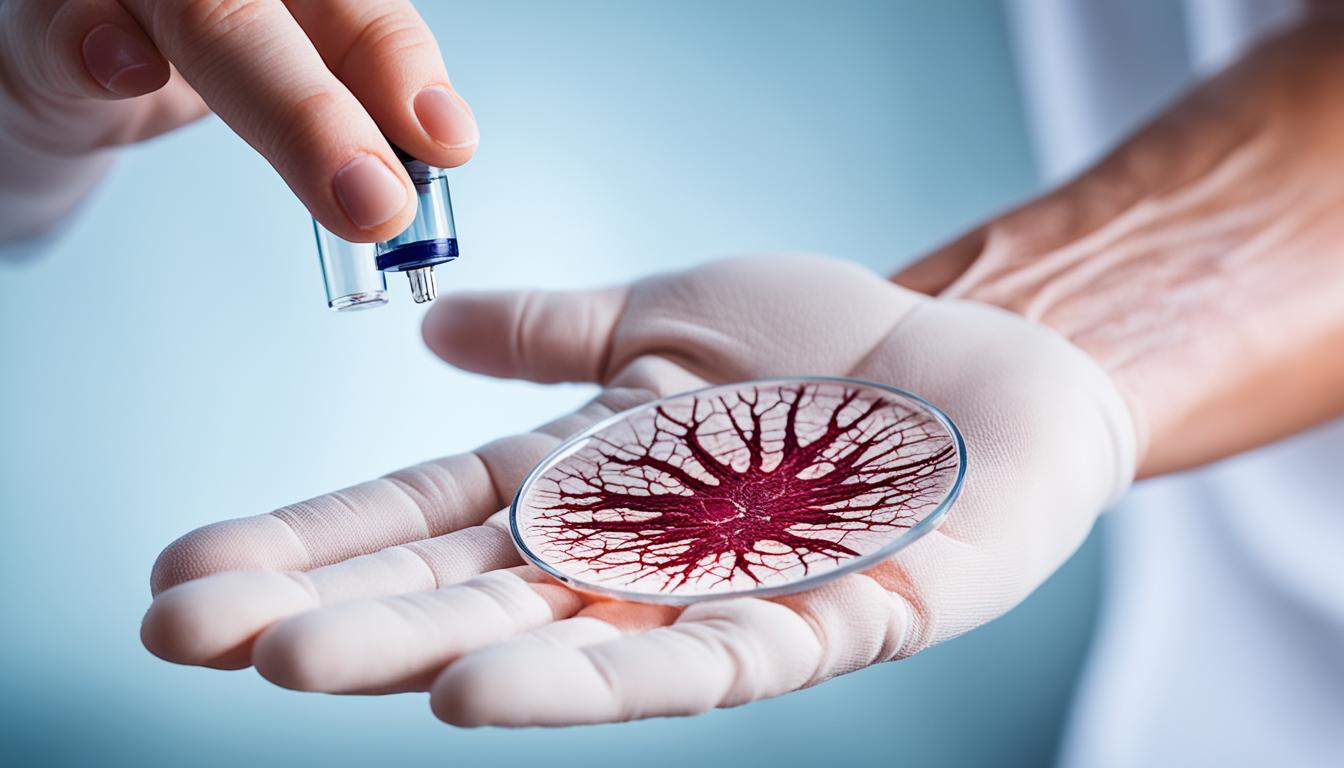Xerosis is the medical term for dry skin. It happens when the top layer of skin lacks enough moisture. This issue is seen a lot in older adults and in dry areas. The main reason for dry skin is the body’s oil glands not making enough sebum. Sebum is what keeps our skin smooth and not dry. Many things can lead to dry skin, like genetic traits or certain illnesses or drugs. If not treated, dry skin can cause redness and itchiness, leading to problems like eczema.
Key Takeaways:
- Xerosis or dry skin is when the top layer of skin doesn’t have enough moisture.
- Issues with the body’s oil production, along with other reasons, can cause dry skin.
- Dry skin can create discomfort, itchiness, and even eczema.
- Keeping the skin moist by using the right lotions and caring for it daily is crucial for treatment.
- In severe situations, using stem cell therapy can help repair the skin.
Symptoms of Xerosis
Xerosis, or dry skin, has several symptoms. These can range from mild to severe. It’s key to know these signs for early treatment. You might notice your skin being:
- Dryness: The skin feels rough and lacks moisture. It can happen anywhere on your body and make your skin tight.
- Itching: Itchy skin is common with xerosis. Without enough moisture, your skin might feel uncomfortable and itchy often.
- Scaling: The skin might start to flake and show scales. This is more likely to happen where we sweat, like on the lower legs.
- Redness: Xerosis can also make your skin look red. It’s a sign of dry skin being irritated and inflamed.
In very bad cases, your skin might crack. This can lead to painful sores that could get infected. Always get help from a doctor if you see these symptoms or if your skin gets worse.
For a look at what xerosis symptoms might appear like, check out the image below:
| Symptom | Description |
|---|---|
| Dryness | The skin feels rough, tight, and lacks moisture. |
| Itching | Uncomfortable sensation leading to persistent scratching. |
| Scaling | The skin flakes and develops visible scales. |
| Redness | Visible inflammation and irritation of the skin. |
| Cracking and painful fissures | In severe cases, the skin may crack, leading to painful fissures that are prone to infection. |
Knowing these early signs of xerosis is very important. It helps in getting the right treatment and stop further skin problems. If you notice any of these symptoms, it’s good to see a doctor. They can give you a clear idea of what’s going on and how to treat it.
Causes and Risk Factors of Xerosis
Xerosis, known as dry skin, has various causes and risks. These can help us prevent and manage it. Here are the main causes:
- The natural aging process can change our skin. It makes oil production lessen, causing less moisture. This makes the elderly more likely to have xerosis.
- If you have a family history of dry skin, you might get it too. This is because of a genetic link, meaning dry skin could run in your family.
- Some health issues like low thyroid function and kidney problems can make skin dry. They affect how well the body stays hydrated, leading to dryness.
- Taking meds to lower your cholesterol can make your skin dry. It’s good to talk with your doctor about how medications can affect your skin.
It’s essential to look at all causes and risks of xerosis together. This way, we can manage it well by treating health issues, adjusting medicines, and using the right skin care.
Treatment and Management of Xerosis
To care for dry skin, keeping it hydrated is key. Using the right moisturizers that lock in moisture is vital. Choose moisturizers made for dry skin and use them often, especially after you bathe.
For better skin, also follow a smart skincare routine. Softly cleanse and exfoliate to get rid of dead skin. This improves your skin’s barrier. Use mild cleansers and skip harsh soaps to keep your skin’s oils.
Sometimes, advanced treatments like stem cell therapy are needed. They help the skin renew and repair itself. Stem cell therapy is a new way to grow new skin cells and improve your skin.
Using moisturizers and a good skincare routine can lessen dry skin symptoms. By caring for your skin daily, you make it healthier and look better.;

